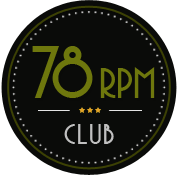VOX
1921 - 1929
VOX Schallplatten- und Sprechmaschinen-Aktiengesellschaft, Berlin was a German record label founded in 1921.
The name "VOX" (Latin for voice) was protected by law as a trademark . It was designed by a professional graphic designer and painter Wilhelm Deffke. The stylized "Negro Head" is one of the most impressive trademarks in the history of the recording industry - a landmark of Art Deco.
Headquarter of VOX was located in the so-called "Vox-Haus", Potsdamer Strasse 39A in Berlin (Germany), from which, incidentally, the first German radio broadcast was aired on October 29th 1923.
The main financial backer of these investments was August Strauch. He made a fortune in diamond business in the former colony of German South West Africa.
At the Leipzig Spring Fair 1922 VOX has been introduced to the public for the first time.
The records - both 30cm and 25cm in diameter - were of good quality. The rotational speed is specified on the labels at 80 rpm.
Inicially there were three price ranges, which were also distinguishable by the color of the labels: red, green and blue.
Within three years, the VOX Company could put together an impressive repertory of own recordings. As a curiosity it should be noted that VOX announced a record of the "Neger-Jazz-Orchesters G. Ruthland Clapham" in September 1924: Since this record is detected in any collection, it may be one of the world's rarest jazz records.
1925 the range was extended by children records of 15cm diameter, which received the brand name "Teddy".
The order numbers has been subdevided as followed:
1000 series: Orchestral recordings
2000 Series: Female Voices
3000 Series: Male Voices
4000 series: Other vocal music
5000 series: Comedy
6000 Series: Instrumental recordings
8000 series: Orchestra recordings
10000 Series: Dutch recordings
20000 Series: Indian recordings
30000 Series: Swedish recordings
35000 Series: Czech recordings
40000 Series: Finnish recordings
Teddy T-series: Children records
Teddy HT Series: Dutch children records
Sperling SP-Series: Language Courses
If the order numbers are preopended by a zero ("0"), they have 30cm in diameter; sometimes an asterisk ("*") was used instead of a zero.
The matrices numbers had also suffixes:
Suffix "-A": 30cm acoustic recording (Germany)
Suffix "-B": 25cm acoustic recording (Germany)
Suffix "-AA": 30cm electrical recording (Germany)
Suffix "-BB": 25cm electrical recording (Germany)
Suffix "-Z": 15cm acoustic recording (Germany)
Suffix "-C": 30cm acoustic recording (foreign)
Suffix "D": 25cm acoustic recording (foreign)
Suffix "-E": 15cm acoustic recording (foreign)
Suffix "-F": 30cm electrical receptacle (foreign)
Suffix "-G": 25cm electrical receptacle (foreign)
The 1st take is characterized by the simple template number ("smoother Take")
The 2nd take is indicated by the suffix "-1", more rarely, by "-½"
The 3rd take is indicated by the suffix "-2", and so on.
After a technical breakthrough with the self invented electrical recordings the label "Electro - Vox" where established in June 1926 with singer Elisabeth Bergner.
Around 1925 VOX was trying to cooperate with american labels. In New York a "Vox Corporation of America" was founded in order to reduce through the exchange of matrices production costs. For unknown reasons, however, the attempts failed - only a few titles were acquired by Radiex. 1927 the American vision was given up. Only one copy of a record of the "Vox Corporation of America" is known.
In 1947, another Vox Records brand emerged in the United States, which has no links to the original German VOX.
In autumn of 1928 VOX took over the exclusive distribution of the English "DuoPhone Unbreakable Records" for Germany.
1929 VOX declarded bankruptcy. The last new releases were announced in February 1929.
The VOX history (german)
Vox 1000-1199-Series: Orchester-Aufnahmen / Orchestra Records - Part 1
Vox 1200-1399-Series: Orchester-Aufnahmen / Orchestra Records - Part 2
Vox 1400-1599-Series: Orchester-Aufnahmen / Orchestra Records - Part 3
Vox 1600-1799-Series: Orchester-Aufnahmen / Orchestra Records - Part 4
Vox 1800- 1999-Series: Orchester-Aufnahmen / Orchestra Records - Part 5
Vox 2000-Series: Damenstimmen / Female Voice Records / Russische Aufnahmen = R.2000
Vox 3000-3199-Series: Herrenstimmen / Male Voice Records - Part 1
Vox 3200-3399-Series: Herrenstimmen / Male Voice Records - Part 2
Vox 3400-3699-Series: Herrenstimmen / Male Voice Records - Part 3
Vox 4000-Series: Mehrstimmige Gesänge / Vocal Duets, Trios, etc
Vox 5000-Series: Komik und Reden / Comic and Spoken Word
Vox 6000-6199-Series: Instrumentalaufnahmen / Instrumental Records - Part 1
Vox 6200-6399-Series: Instrumentalaufnahmen / Instrumental Records - Part 2
Vox 8000-8199-Series: Orchester-Aufnahmen / Orchestra Records - Part 1
Vox 8200-8399-Series: Orchester-Aufnahmen / Orchestra Records - Part 2
Vox 8400-8599-Series: Orchester-Aufnahmen / Orchestra Records - Part 3
Vox 8600-8699-Series: Orchester-Aufnahmen / Orchestra Records - Part 4
Vox 10.000-10199-Series: Holländische Aufnahmen / Dutch Records - Part 1
Vox 10.200-10300-Series: Holländische Aufnahmen / Dutch Records - Part 2
Vox 20.000-Series: Indische Aufnahmen / Indian Records
Vox 30.000-Series: Schwedische Aufnahmen /Swedish Records
Vox 35.000-Series: Tschechiche Aufnahmen /Czech Records
Vox 40.000-Series: Finnische Aufnahmen / Finnish Records
Vox 40.000-Series: Türkische Aufnahmen / Turkish Records TÜRK SESI / THE TURK'S VOICE
Teddy T-Series: Kinder-Schallplatten / Children´s Records
Vox Teddy-9000-Series: Parallel-Serie: Vox T-Series
Teddy HT-Series: Holländische Kinder-Schallplatten / Dutch Children´s Records
Sperling-SP-Series: Sprachkurse/Language Instruction Records
Source: Lotz-Verlag




